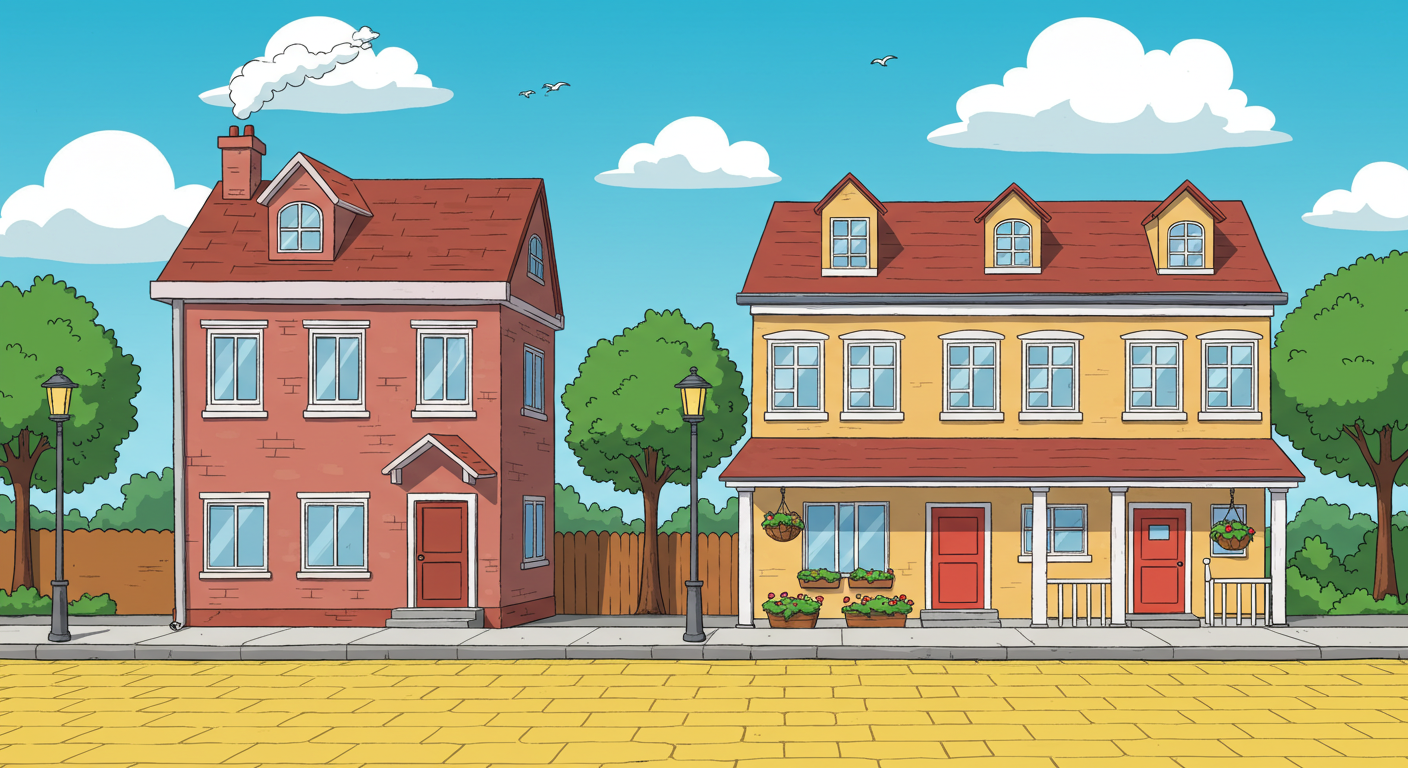Duplex vs Townhouse: The Differences Between Them [+ Free Comparison Chart Download]
Unlike duplex apartments, townhouses usually feature individual ownership of each dwelling unit, though they can certainly function as rental properties

The choice between investing in a duplex vs townhouse goes beyond architectural preferences. It's a strategic decision that impacts everything from your monthly cash flow to your long-term wealth building strategy. Both property types offer unique advantages for rental property investors, but they come with distinct management challenges and profit potential.
You'll learn: What defines each property type, how they compare for rental income generation, legal and management considerations, and practical strategies for maximizing your investment returns in both duplex and townhouse properties.
What Is a Duplex vs Townhouse?
Duplex: Two Homes, One Structure
A duplex is a single structure that contains two separate living spaces, each functioning as an independent rental unit. Think of it as two apartments sharing a common wall or floor-ceiling configuration within one building. Each unit typically features its own entrance, kitchen, bathroom, and living areas—essentially creating two complete homes under one roof.
Duplex owners can choose from several common configurations:
- Side-by-side units sharing a central wall (most common)
- Stacked units with one apartment above another
- Semi-detached house style where units share minimal wall space
The key advantage of a duplex house is that you're dealing with a single structure on one lot, which simplifies property taxes, insurance, and exterior maintenance responsibilities.
Townhouse: Connected Yet Independent
A townhouse represents a different approach to multi-unit building design. These are typically multiple homes connected in a row, with each unit extending from ground to roof across multiple floors. Unlike duplex apartments, townhouses usually feature individual ownership of each dwelling unit, though they can certainly function as rental properties.
Townhouse owners enjoy several distinct characteristics:
- Individual property ownership (fee simple)
- Private yard space (front, back, or both)
- Separate living spaces across multiple levels
- Shared walls with neighboring units
- Often part of a homeowners association (HOA)
The fundamental difference: while a duplex functions as one property with two rental units, townhouses are typically individual properties that happen to share walls with neighbors.
Duplex vs Townhouse
Property Management Comparison Guide
Duplex
-
Single structureTwo separate living units in one building
-
Shared wall or floor/ceilingUnits connected by common boundaries
-
One owner controls both unitsMaximum control over rental decisions
-
FHA loans available3.5% down payment for owner-occupants
-
House-hacking potentialLive in one unit, rent the other
-
Simple property managementOne building, one tax bill, unified operations
-
Coordinated maintenanceShared systems require unified approach
-
Higher rental income$3,200-$4,800/month from dual units
Townhouse
-
Individual properties connectedSeparate units attached in rows
-
Multiple floors with private entrancesVertical living space, individual access
-
Fee simple ownershipIndividual property ownership rights
-
HOA governance structureCommunity rules and shared amenities
-
Private yard spaceFront and/or back outdoor areas
-
Premium rent potentialCommunity amenities justify higher rates
-
Variable maintenance responsibilityDepends on HOA agreements and bylaws
-
Higher appreciation potentialValue growth in desirable communities
Key Management Differences
Why This Choice Matters in Property Management
Income Generation Potential
The duplex vs townhouse decision significantly impacts your rental income strategy. Duplex owners can generate income from both units while maintaining control over the entire property. This arrangement often provides more predictable cash flow since you're not dependent on HOA decisions or neighboring property maintenance standards.
Recent market data shows that duplex apartments in major metropolitan areas generate an average of $3,200-$4,800 monthly from both units combined, compared to single-family homes averaging $1,800-$2,400 per month. For comparison, the rental yield on well-located duplexes often exceeds single-family properties by 15-25%.
Townhouse rental income varies more widely based on location and homeowners association amenities. Properties with access to shared amenities like pools, fitness centers, or common spaces can command premium rents—sometimes 15-20% above comparable single-family homes. Understanding property amenity strategies becomes crucial for maximizing townhouse rental potential.
Recent data from build-to-rent communities shows that purpose-built townhouse rental communities often outperform traditional single-family rentals by 12-18% in monthly income due to their amenity packages and professional management.
Management Complexity Factors
Managing a rental property with multiple units introduces specific operational challenges:
For Duplexes:
- Coordinating maintenance access across both units
- Managing tenant relationships in close proximity
- Handling shared utility systems and exterior maintenance
- Dealing with noise complaints between units
For Townhouses:
- Understanding HOA dues and regulations
- Coordinating with home owners association for common area maintenance
- Managing individual unit maintenance while respecting shared wall agreements
- Navigating CC&R restrictions on rental activities
Real-World Applications: Success Stories and Scenarios
Example 1: The House-Hacking Duplex Strategy
Challenge: A new real estate investor in Austin wanted to minimize housing costs while building wealth through real estate investing.
Solution: She purchased a duplex for $380,000 using an FHA loan with just 3.5% down. She moved into one unit and rented the other for $1,850/month.
Outcome: Her monthly mortgage payment was $2,100, but rental income covered 88% of the cost. After two years, she moved out and rented both units, generating $3,600 monthly income.
Takeaway: Duplex owners can leverage owner-occupant financing to minimize down payments while maximizing income potential.
Example 2: Townhouse Community Management
Challenge: A property management company inherited 12 townhouse rental units scattered across three HOA communities, each with different rules and shared amenities.
Solution: They created community-specific management protocols, established relationships with each homeowners association, and implemented automated HOA dues tracking systems.
Outcome: Average rent increased 12% due to better amenity marketing, and maintenance costs decreased 18% through coordinated vendor relationships.
Takeaway: Understanding common spaces and HOA dynamics can transform townhouse management from a challenge into a competitive advantage.
Example 3: Urban Multi-Unit Building Conversion
Challenge: A property developer in New York City wanted to maximize rental income from a narrow lot in a high-demand neighborhood.
Solution: Instead of building a traditional apartment building, they created a modern duplex design with separate entrances and outdoor space for each unit.
Outcome: The property generates 40% more monthly income than comparable single family home rentals in the area, while maintaining the intimate feel tenants prefer over large apartment buildings. The owner used After Repair Value (ARV) calculations to determine optimal renovation investment levels.
Takeaway: Creative duplex design can compete effectively with both single family homes and larger multi unit buildings in urban markets when supported by proper financial analysis.
Legal and Compliance Considerations
Federal Regulations and Financing
FHA Loan Requirements: Both duplexes and townhouses qualify for FHA financing under specific conditions. Duplex owners can secure loans with as little as 3.5% down payment if they plan to owner-occupy one unit. Townhouses qualify individually, making them accessible to more buyers but potentially creating more competition for rental properties. The Federal Housing Administration guidelines provide detailed eligibility requirements for multi-unit properties. Understanding certificate of occupancy requirements becomes essential for both property types.
Fair Housing Compliance: Multi-unit properties face heightened scrutiny under Fair Housing Act regulations. Property managers must ensure consistent application of tenant screening criteria across all units, whether managing a single duplex or multiple townhouses. The Department of Justice housing enforcement cases demonstrate the serious consequences of discriminatory practices in multi-unit property management.
State and Local Variations
Zoning Restrictions: Many municipalities have specific zoning requirements for multi unit buildings. Some areas restrict duplex construction to preserve single family home neighborhood character, while others encourage higher-density development. Understanding appraised value factors helps navigate these zoning decisions and their impact on property values.
HOA Rental Restrictions: Townhouse owners often encounter HOA-imposed rental restrictions, including:
- Minimum lease terms (commonly 6-12 months)
- Maximum percentage of rental units in the community
- Required landlord registration with the association
- Restrictions on featured listings and advertising methods
Understanding common area maintenance responsibilities helps navigate complex HOA relationships and cost allocations.
Rent Control Considerations: Several states have different rent control applications for attached vs. detached properties. Twin home and townhouse properties may face different regulations than traditional duplex apartments.
Best Practices for Duplex and Townhouse Management
1. Optimize Tenant Screening for Multi-Unit Success
What it is: Enhanced screening protocols designed for properties with shared walls and common areas.
Why it matters: Tenant compatibility becomes crucial when people live in close proximity. Poor screening can lead to neighbor disputes, noise complaints, and higher turnover.
How to do it:
- Implement comprehensive background checks including previous rental behavior
- Screen for lifestyle compatibility (work schedules, pets, noise sensitivity)
- Verify income at 3x monthly rent for each unit
- Check references specifically about neighbor relationships
Tools to use: Start with credit reports and tenant selection criteria to establish baseline standards. Understanding credit score ranges helps set appropriate thresholds. For complex situations, review guidelines on lease co-applicants and co-signer agreements.
2. Master HOA Relationships for Townhouse Success
What it is: Proactive engagement with homeowners associations to maximize property value and tenant satisfaction.
Why it matters: Strong HOA relationships can provide access to premium shared amenities and smoother maintenance coordination.
How to do it:
- Attend monthly HOA meetings or send a representative
- Understand all CC&R restrictions before marketing
- Budget for HOA dues increases (typically 3-5% annually)
- Leverage common spaces and amenities in marketing materials
Tools to use: HOA management platforms like AppFolio Association Manager or TOPS Software.
3. Streamline Maintenance for Shared Wall Properties
What it is: Coordinated maintenance protocols that account for shared walls and interconnected systems.
Why it matters: Maintenance issues in attached properties often affect multiple units, requiring careful coordination and communication.
How to do it:
- Create maintenance schedules that minimize tenant disruption
- Establish clear protocols for accessing separate living spaces
- Maintain relationships with contractors experienced in attached housing
- Document all shared wall and common system maintenance
Tools to use: Maintenance tracking software and vendor management platforms. Document all shared wall and common system maintenance with property tax considerations in mind, especially for tenant-responsible utilities.
4. Maximize Income Through Strategic Amenity Marketing
What it is: Positioning shared amenities and outdoor space as premium features that justify higher rents.
Why it matters: Properties with well-marketed amenities can command 10-20% rent premiums over standard rentals.
How to do it:
- Highlight private yard space in featured listings
- Showcase common area amenities with professional photography
- Create virtual tours emphasizing living space flow and outdoor space
- Market multiple floors as additional privacy and space
Tools to use: Professional photography services, virtual tour software, and premium listing platforms.
5. Implement Technology for Multi-Unit Efficiency
What it is: Leveraging property management technology to handle the complexity of multiple units and tenant relationships.
Why it matters: Technology reduces management overhead while improving tenant communication and satisfaction.
How to do it:
- Use automated rent collection for all units
- Implement digital maintenance request systems
- Set up automated tenant communication for community updates
- Track HOA dues and community compliance electronically
Tools to use: Calculate investment potential using gross rent multiplier analysis and cap rate calculations to compare duplex vs townhouse opportunities effectively.
Related Concepts and Terminology
Condo vs Townhouse: Understanding the difference between condos and apartments helps clarify ownership structures. Condominiums involve shared ownership of common areas, while townhouses typically provide individual ownership of the entire structure plus yard space. This distinction affects rental property management, particularly regarding maintenance responsibilities and HOA involvement.
Twin Home: A specific type of duplex where two mirror-image homes share walls but maintain separate ownership. Popular in markets where detached house options are limited, twin homes offer a middle ground between single family homes and apartment buildings.
Multi Unit Building: Broader category encompassing duplexes, townhouses, and larger apartment buildings. Understanding this classification helps property managers navigate financing options and regulatory requirements that often differ based on unit count.
Common Wall Maintenance: Legal and practical considerations for maintaining shared walls between units. Includes responsibility allocation, cost sharing, and access rights for repairs affecting multiple dwelling units.
Fee Simple Ownership: The most complete form of property ownership, typically associated with townhouses and single family homes. Understanding ownership structures helps property managers navigate maintenance responsibilities and tenant rights in different property types.
Common Questions About Duplex vs Townhouse Management
What are the key differences between duplexes and townhouses in real estate?
Property structure represents the primary difference. A duplex consists of two rental units within a single structure, while townhouses are individual properties connected by shared walls. Duplexes typically involve one owner managing two units, whereas townhouses often have separate ownership for each unit. This affects everything from financing options to management complexity and HOA involvement.
What kind of maintenance responsibilities can you expect with a townhouse?
Townhouse owners handle interior maintenance, individual unit systems, and often private yard upkeep. Exterior maintenance responsibilities vary significantly—some homeowners associations cover roof, siding, and common areas, while others require individual owners to maintain their portion. Always review HOA documents carefully, as maintenance responsibilities directly impact operating costs and tenant expectations.
What are the advantages of living in a townhouse or duplex?
Duplex apartments offer more space than traditional apartments while typically costing less than single family homes. Tenants enjoy separate living spaces with private entrances and often outdoor space. Townhouses provide the feeling of homeownership with multiple floors, private yards, and access to shared amenities like pools or fitness centers. Both options offer more privacy than apartment buildings while remaining more affordable than detached homes.
What exactly is a duplex and how does it differ from a condo or townhouse?
A duplex house contains two complete dwelling units sharing either a wall or floor/ceiling within one building structure. Condos involve shared ownership of common areas and building systems, while townhouses are individually owned properties that share walls with neighbors. The key difference for property managers: duplexes function as multi unit buildings under single ownership, condos involve complex association governance, and townhouses balance individual ownership with homeowners association oversight.
What are the most important factors to consider when choosing between a duplex and townhouse for Airbnb?
Location and local regulations top the list. Many homeowners associations restrict short-term rentals, making townhouse Airbnb operations challenging. Duplexes offer more control but require managing two units simultaneously. Consider shared amenities availability (pools, gyms), parking access, and noise management between units. Duplex owners can optimize one unit for Airbnb while maintaining long-term tenants in the other, providing income stability that townhouse operators can't replicate.
Maximizing Your Multi-Unit Investment Success
The duplex vs townhouse decision ultimately depends on your investment goals, management capacity, and local market conditions. Both property types offer compelling advantages for building rental income and long-term wealth.
Key takeaways for property managers:
- Duplexes provide maximum control and income potential within a single structure
- Townhouses offer individual property ownership with potential shared amenities that justify premium rents
- Understanding HOA dynamics is crucial for townhouse success
- Technology and systems become essential for managing multiple homes efficiently
Property developers and home builders continue innovating in both categories, creating modern designs that maximize living space, outdoor space, and rental property appeal. Whether you choose the coordinated management of a duplex or the community-oriented approach of townhouse rentals, success comes from understanding your tenants' needs and leveraging each property type's unique advantages.
Ready to dive deeper into multi-unit property management? Explore our comprehensive guides on tenant screening, HOA management, and rental property financing to build your expertise and maximize your investment returns.





